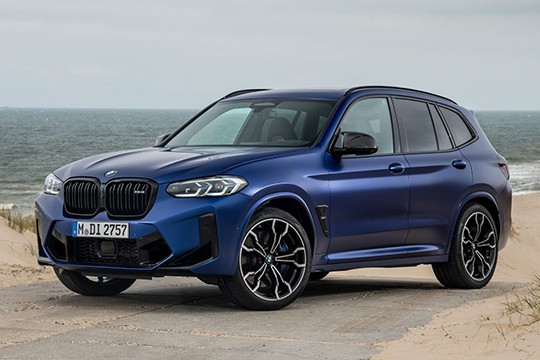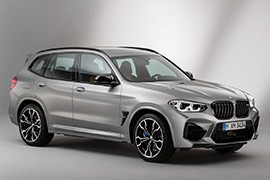BMW X3 M Models/Series Timeline, Specifications & Photos
First production year: 2019
Engines: Gasoline, Hybrid
Body style: SUV (Sports Utility Vehicle)
BMW introduced a facelift for the X3's third generation in 2021, and, along with the rest of the range, it unveiled the life-cycle impulse for the X3 M.
The X3 appeared on the market in 2003 as a compact SUV. While customers did not appreciate its Chris Bagle design styling, the vehicle's qualities convinced them. So, from the third generation, the German carmaker introduced a much-waited M version. At first, it was just the M 4.0i package from 2018, and then, the full M-version stormed the Autobahn with its 480 horses under the hood.
The design team knew that it could do a better job for the 2017 X3. So, the compact SUV received an M Competition package that included a new front fascia with narrower headlights by 10 mm (0.4"), like the rest of the 2021 X3s. As an option, they could feature an adaptive LED with MATRIX function. Its grille was piano-black with vertical slats, which matched the apron's look. At the back, the X3 M Competition featured new LED taillights with a unique design and a diffuser under the bumper.
BMW change the X3 M's interior with a new redesigned center console. It sported a new gear-selector, the i-Drive dial, and buttons. Above the center stack, the carmaker placed a 12", wide-format touch-screen for the infotainment unit. The most significant change was on the digital instrument panel, which featured the Driving Assistant Professional as standard, which trained the driver. In addition, the new system allowed integration with Amazon Alexa via the My BMW app.
Under the hood, BMW upgraded the 3.0-liter turbocharged inline-six from the X3 M with a crankshaft carried over from the M4. Thus, it could increase the power and, as a result, it dropped the 0-62 mph run to 3.8 seconds.
BMW introduced the first M-badged X3 model in 2019, offering its customers an excellent go-fast all-around crossover that could keep up with hot hatches and sports cars in terms of performance.
The X3 was already successful, and the automaker enjoyed big sales numbers with it. But customers started to ask for more power and more performance from what was supposed to be just a premium daily driver SUV. As a result, BMW’s motorsports department focused on the X3 model after it was done making other high-performance versions for the carmaker’s models.
It was the first X3 to receive an M-treatment, and the result was excellent. But the engineers didn’t just put a more powerful engine under the vehicle’s hood and call it a day. Instead, they transformed it from tip to toe and from bumper to bumper.
While the engineers were busy working on the drivetrain, the exterior designers created a new look for the X3 M. The crossover received a new bumper up front with a deeper apron that featured a broad air intake in the middle and a pair of scoops on the sides, although those were just for design since they were not air intakes. The massive grille was blacked out to create a meaner aspect for the improved version of the X3.
From its profile, the front fenders were different than for the rest of the range, featuring a set of exhaust vents behind the wheel arches. Unfortunately, those were fake. Still, they amplified the sporty look of the car. The door mirrors were typically M-design, with an additional horizontal slat towards the A-pillars. Since the X3 M had a lower ground clearance than its non-M sibling, it also got a set of aerodynamically-profiled side sills. At the back, the slightly racked-forward tailgate was adorned by a roof spoiler at the top and four exhausts underneath the bumper.
Inside, the automaker installed standard sports seats with high bolstered areas and leather upholstery. Fronting the driver was a digital instrument cluster, while atop the center stack, in a free-floating position, was the infotainment unit.
Between the front occupants, on the center console, BMW placed the buttons that controlled the driving modes and the gear selector. The steering wheel was also unique for the M-version, featuring two additional customizable buttons for various functions. In the back, there was room enough for three passengers on the split-folding bench seat.
But the real magic of the vehicle happened under its skin. The newly-developed S58 twin-turbocharged gasoline engine provided enough power and torque to propel the car from zero to sixty in less than four seconds, with a limited top speed of 155 mph (250 kph), although as an option, BMW offered a raise for that value.
Besides the engine and the eight-speed automatic transmission fitted with a launch-control function, the car also has other essential upgrades. The braking system boasted four-pot calipers and large discs, and the suspension featured stiffer anti-roll bars than the regular X3.

